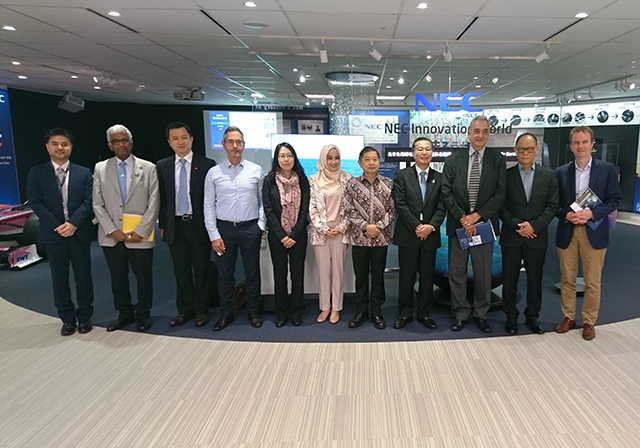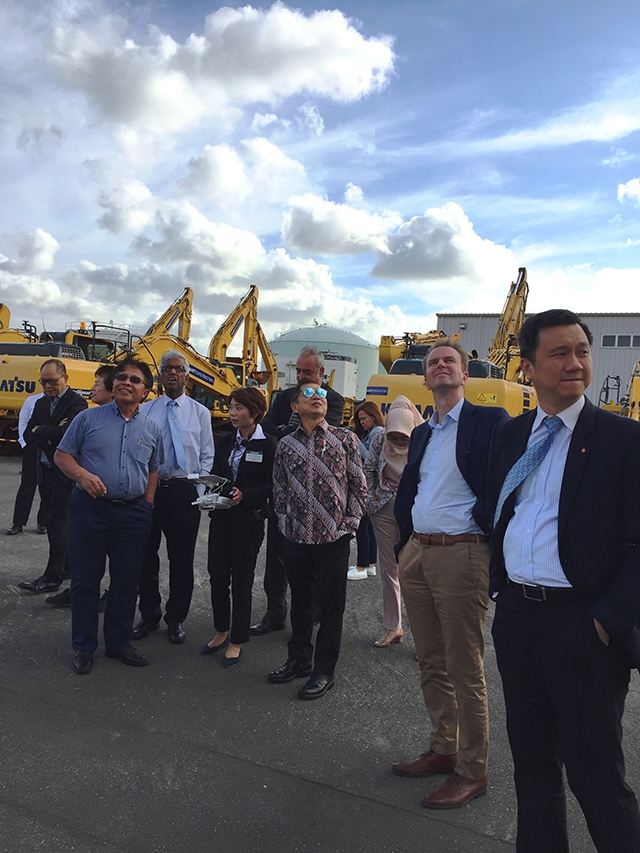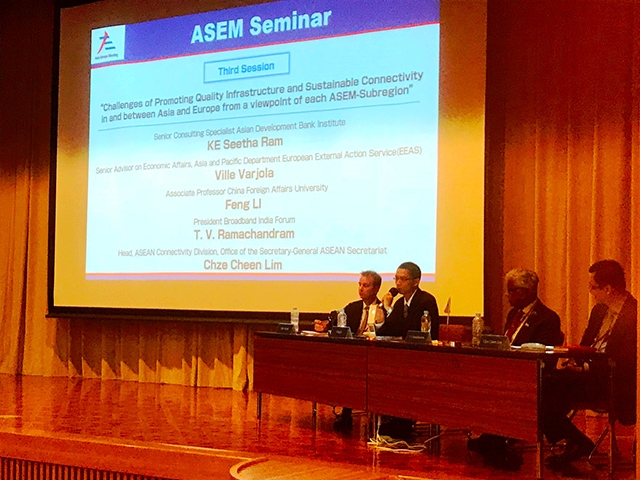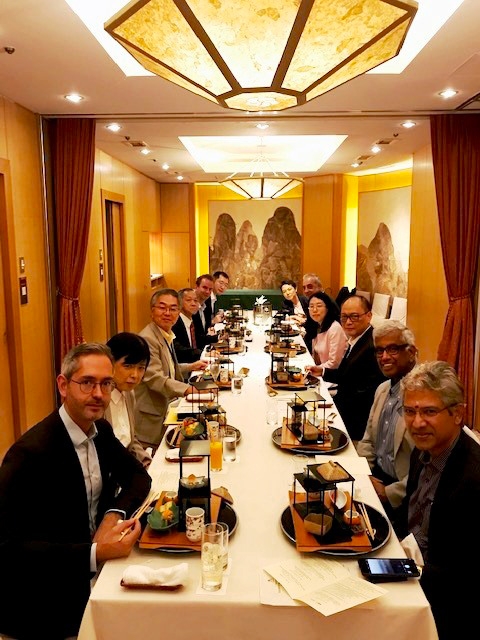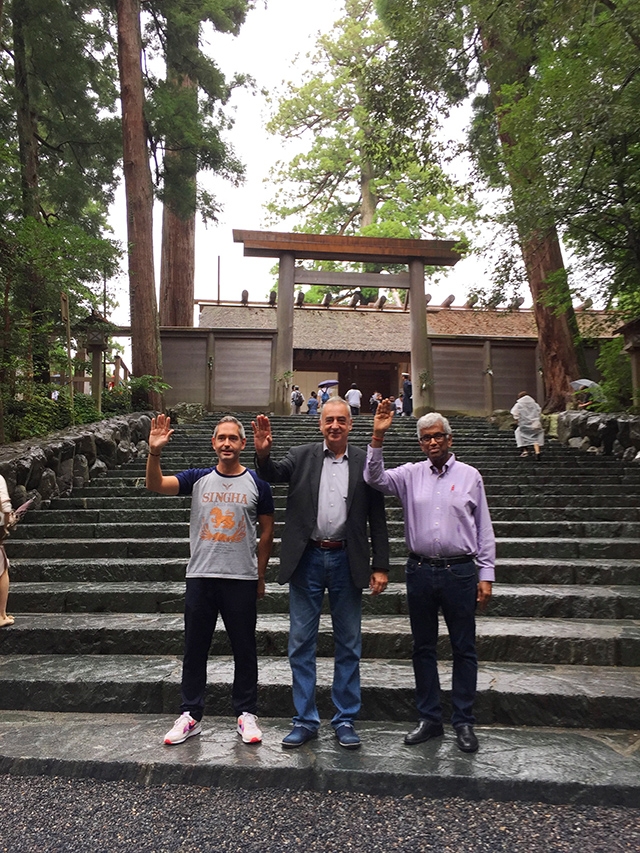B. The travel to Tokyo and arrival there:
I left for Tokyo by JAL flight JL 740, departing Delhi at 7.35 pm on Saturday, 8th Sept. The 7.5 hour flight was very comfortable and the JAL inflight service excellent. Arrived in Tokyo on Sunday, 9th Sept morning. The formalities were very smoothly handled at Narita Airport, where I was met on arrival by a person deputed by MOFA and escorted in a chauffeur-driven car to the beautiful 5star hotel, New Otani, in the centre of the city, not far from the government offices. There being no official programme for 9th, we were left to rest, relax and attend to our other work as we wished.
C. Some of the other invitee external delegates to the ASEM Seminar that I met:
- Mr Benjamin E. Diokno, PhD, Secretary, Department of B & M, Government of Philippines,
- Mr Suharso Monoarfa, The President Advisory Council, Republic of Indonesia,
- Ms Hj.Nurhayati Monoarfa, Member of Parliament, Republic of Indonesia,
- Dr Chairil Abdini, Member of Policy Research Team, PAC, Republic of Indonesia,
- Prof Jun Hae-Won, Korea National Diplomatic Academy, Ministry of Foreign Affairs,
- Mr Plamen Tonchev, Head, Asia Unit, Institute of International Economic Relations, Greece,
- Dr Serhat Unaldi, Senior Manager-Japan, APA, Federation of German Ind., Germany,
- Mr Ville Varjola, Adviser on Economic Affairs, APAC, European External Action Service,
- Prof Li Feng, China Foreign Affairs University, School of International Economics, Beijing,
- Mr Lim Chhze Cheen, Head/Director, ASEAN Connectivity Division, Jakarta, Indonesia,
- Ms Joan M Kabigting, EA to Secretary Dept of B&M, Govt of Philippines.
The above is by no means an exhaustive and complete list and includes only those with whom interactions were more. My apologies if I have missed any.
D. Ministerial Meetings on 10th Forenoon Session:
1. With MOFA & JICA:
We were met by Mr Masato Ohtaka, Deputy Assistant Minister, Foreign Policy Bureau. Also present were Messrs Yoshie Nakatani Otsuka, Director, MOFA, Toshiya Abe, Senior Director, Operations Strategy Department, JICA (Japan International Cooperation Agency).
Mr Ohtaka explained their New Foreign Policy Strategy based on the concepts of Free and Open Indo-Pacific Strategy, diplomacy that takes a panoramic view of the world and a proactive contribution to Peace based on the principle of international cooperation. They stated that, in Asia, Japan would further promote infrastructure development, trade and investment, and enhance business environment and human development, strengthening connectivity in the ASEAN region. The 3 Specifics of their Indo-Pac Strategy would be i) Promotion and establishment of the rule of law, freedom of navigation, free trade etc, ii) Pursuit of Economic Prosperity and iii) Commitment for Peace and Stability. Mr Abe of JICA highlighted that JICA believes in Cooperation for creating Quality Infrastructure and is the largest bilateral donor agency and involved with over 150 countries. They are of the view that Quality Growth is comprised of 3 essential elements of Inclusiveness, Sustainability and Resilient Growth. The fruits of growth need to be shared with society as a whole, leaving no one behind. Growth must also be in a sustainable manner and in harmony with the environment including addressing climate change. Last but not least, the growth must have the resilience to withstand and recover from economic crises, natural disasters and other shocks. Interesting also to note that they believe in consistent approach rather than mere strength, and like to smoothly flow or evolve from Development Policy through Master Plan to Integrated Assistance that combines assistance for “hard(physical) and soft(non-physical)” infrastructure. The various transportation projects by them in India were quoted as examples.
2. With METI (Ministry of Economy, Trade & Industry)
At METI, Mr Kohei Toyoda, Director for International Coordination, Trade Policy Bureau, and Mr Shun Hidai, Deputy Director – Trade Promotion division interacted with us. Mr Toyoda made a detailed presentation on the subject of “Initiatives for Quality of Infrastructure Development and Investment”. The highlight was the revision of the 2014 APEC Guidebook on the subject which had been based on the 3 key elements of Life cycle cost reduction, Environmental and other impacts and Safety assurance. Since then there have been new developments and initiatives like the 2016 G7 Ise-Shima Principles for Promoting Quality Infrastructure Investment, the 2016 G20 Hangzhou Declaration of Actions to Support Infrastructure Investment and the 2015 UN Agenda for Sustainable Development Goals. Hence, in the light of rapid evolution of the global economy and increased importance of infrastructure to sustain it, in 2017 in Da Nang, Viet Nam, APEC Ministers welcomed an initiative to upgrade the 2014 Guidebook.
From 3 Elements in the 2014 Guidebook, the new revised Guidebook is looking at 5 Elements: 1.Alignment with Development strategy/Openness/Transparency/Fiscal Soundness; 2. Economic and Financial soundness including cost effectiveness (including life cycle cost); 3. Local development through job creation, capacity building and transfer of technology; 4. Social and environmental responsibility; and 5. Stability/Safety, Resilience. They explained at length about the aspects of the revision work.
3. With MOF (Ministry of Finance):
At the MOF, we were looked after by Mr Munenari Nomura, Director Development and Mr Takahiro Tsuda, Director Policy Coordination. It was shown how the infrastructure gap is very large, being as high as 26 trillion dollars by 2030 for Asia as per ADB. India was highlighted as one of the countries needing significant infrastructure investment. Multi-dimensional financing channels are required to help meet the requirement. The G20 has infrastructure investment as a key agenda item and Japan has strong bilateral efforts to support infrastructure. While various organisations are doing their bit, JICA is in charge of administering all bilateral Official Development Assistance (ODA). It is the world’s largest bilateral aid agency and works in over 150 countries and regions and has about 90 overseas offices. We were apprised of the MOF’s and JIC’s initiatives and actions to support the creation of quality infrastructure, including the exercise to upgrade the Guidebook as per the 2016 Hanzhou decision.
E. Visit to Shimizu Corporation’s Institute of Technology – Afternoon of 10th Sept.:
Here we were received by Mr Masahiro Araki, General Manager and his team. Shimuzu Corporation is a venerable corporate in the creation of hi-quality construction infrastructure in Japan and tracing its origin to as far back as 1804 when Kisuke Shimizu started operations in the district of Edo. About 14.3 billion USD turnover and about 15000 employees. A great sense of craftsmanship and quality pervades the organisation. Shimuzu R&D and engineering are focussed on building robust, reliable and highly durable structures. They believe in urban development that is friendly to both people and the environment. The facilities at the Institute of Technology were very impressive. Special mention must be made of the very advanced shaking table equipment for testing durability in the face of powerful earthquakes. Very particular attention paid to the environmental preservation. e.g. in construction sites, they follow special suppressed lighting and hoods to minimize effect on environmental life like insects, animals etc.
F. Special Welcome Dinner hosted by MOFA:
In the evening of 10th we were hosted a special welcome dinner to the delegates by MOFA. On behalf of the Hon’ble Minister Horii, who had to travel to his constituency to supervise recovery from an earthquake, His Excellency Mr Jun Saito, Ambassador for ASEM and DDG, European Affairs Bureau was the host and presided over the discussions and the delightful dinner. Dr K E Seetha Ram of ADB and other officials from MOFA and JICA also joined the dinner and discussion. A lovely finish to a very useful and interesting day.
